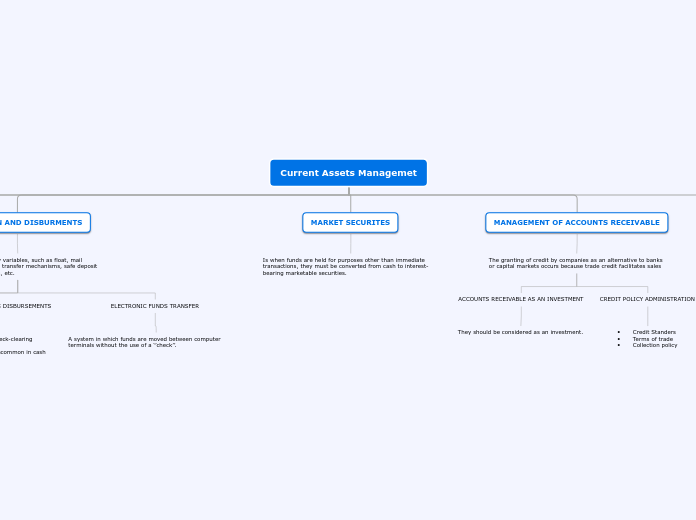Current Assets Managemet
COST BENEFITS ANALYSIS
It provides a framework for identifying all changes resulting from a decision, some results will be incremental, increasing the value of the company, and others will be decremental, decreasing value.
It must consider explicit and implicit costs and benefits.
CASH MANAGEMENT
Knowledge of the cash flow cycle can help in understanding cash management, and financial forecasting proformas as they are invaluable tools for identifying the cash needs of the business.
Reasons for Holding Cash Balances
Transactions balances, for compensating balances for Banks, and for precautionary needs.
COLLECTION AND DISBURMENTS
It is a function with many variables, such as float, mail systems, electronic funds transfer mechanisms, safe deposit boxes, international sales, etc.
Float
Is due to shipping delays
IMPROVING COLLECTIONS AND EXTENDING DISBURSEMENTS
• We may expedite the collection and check-clearing process through several strategies
• The slowing of disbursements is not uncommon in cash management.
ELECTRONIC FUNDS TRANSFER
A system in which funds are moved between computer terminals without the use of a ‘’check’’.
MARKET SECURITES
Is when funds are held for purposes other than immediate transactions, they must be converted from cash to interest-bearing marketable securities.
MANAGEMENT OF ACCOUNTS RECEIVABLE
The granting of credit by companies as an alternative to banks or capital markets occurs because trade credit facilitates sales
ACCOUNTS RECEIVABLE AS AN INVESTMENT
They should be considered as an investment.
CREDIT POLICY ADMINISTRATION
• Credit Standers
• Terms of trade
• Collection policy
INVENTORY MANAGEMENT
All of these forms of inventory need to be financed, and their efficient management can increase a firm’s profitability.
INVENTORY POLICY IN INFLATION (AND DEFLATION)
The problem can be partially controlled by taking moderate inventory positions.
THE INVENTORY DECISION MODEL
The two basic costs associated with inventory must be evaluated: transportation costs and ordering costs.
SAFETY STOCK AND STOCKOUTS
•Occurs when a company runs out of a specific inventory item and is unable to sell or deliver the product.
• Is inventory held in addition to regular requirements to protect against a shortage of an item.
JUST-IN-TIME
•Quality production that continually satisfies customer requirements
•Close ties between suppliers, manufacturers, and customers
•Minimization of the level of inventory
